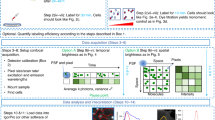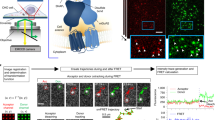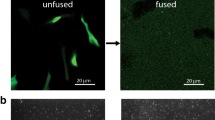Abstract
Here we describe an approach to investigate di- or oligomerization of transmembrane receptors in living cells with fluorescence recovery after photobleaching (FRAP). We immobilized a defined fraction of receptors with antibodies and then measured lateral mobility of the nonimmobilized fraction by FRAP. We validated this approach with CD86 and CD28 as monomeric and dimeric reference proteins, respectively. Di- or oligomerization of G protein–coupled receptors is strongly debated. We studied human β-adrenergic receptors as prototypical G protein–coupled receptors and found that β1-AR shows transient interactions whereas β2-AR can form stable oligomers. We propose that this FRAP method can be widely applied to study di- or oligomerization of cell-surface proteins.
This is a preview of subscription content, access via your institution
Access options
Subscribe to this journal
Receive 12 print issues and online access
$259.00 per year
only $21.58 per issue
Buy this article
- Purchase on SpringerLink
- Instant access to full article PDF
Prices may be subject to local taxes which are calculated during checkout





Similar content being viewed by others
References
Angers, S., Salahpour, A. & Bouvier, M. Dimerization: an emerging concept for G protein-coupled receptor ontogeny and function. Annu. Rev. Pharmacol. Toxicol. 42, 409–435 (2002).
Jones, K.A. et al. GABAB receptors function as a heteromeric assembly of the subunits GABABR1 and GABABR2. Nature 396, 674–679 (1998).
White, J.H. et al. Heterodimerization is required for the formation of a functional GABAB receptor. Nature 396, 679–682 (1998).
Fotiadis, D. et al. Atomic-force microscopy: rhodopsin dimers in native disc membranes. Nature 421, 127–128 (2003).
Suda, K., Filipek, S., Palczewski, K., Engel, A. & Fotiadis, D. The supramolecular structure of the GPCR rhodopsin in solution and native disc membranes. Mol. Membr. Biol. 21, 435–446 (2004).
Angers, S. et al. Detection of beta 2-adrenergic receptor dimerization in living cells using bioluminescence resonance energy transfer (BRET). Proc. Natl. Acad. Sci. USA 97, 3684–3689 (2000).
Mercier, J.F., Salahpour, A., Angers, S., Breit, A. & Bouvier, M. Quantitative assessment of beta 1- and beta 2-adrenergic receptor homo- and heterodimerization by bioluminescence resonance energy transfer. J. Biol. Chem. 277, 44925–44931 (2002).
James, J.R., Oliveira, M.I., Carmo, A.M., Iaboni, A. & Davis, S.J. A rigorous experimental framework for detecting protein oligomerization using bioluminescence resonance energy transfer. Nat. Methods 3, 1001–1006 (2006).
Bouvier, M., Heveker, N., Jockers, R., Marullo, S. & Milligan, G. BRET analysis of GPCR oligomerization: newer does not mean better. Nat. Methods 4, 3–4 author reply 4 (2007).
Salahpour, A. & Masri, B. Experimental challenge to a 'rigorous' BRET analysis of GPCR oligomerization. Nat. Methods 4, 599–600 author reply 601 (2007).
Lopez-Gimenez, J.F., Canals, M., Pediani, J.D. & Milligan, G. The alpha1b-adrenoceptor exists as a higher-order oligomer: effective oligomerization is required for receptor maturation, surface delivery, and function. Mol. Pharmacol. 71, 1015–1029 (2007).
Maurel, D. et al. Cell-surface protein-protein interaction analysis with time-resolved FRET and snap-tag technologies: application to GPCR oligomerization. Nat. Methods 5, 561–567 (2008).
Picard, D., Suslova, E. & Briand, P.A. 2-color photobleaching experiments reveal distinct intracellular dynamics of two components of the Hsp90 complex. Exp. Cell Res. 312, 3949–3958 (2006).
Lippincott-Schwartz, J., Snapp, E. & Kenworthy, A. Studying protein dynamics in living cells. Nat. Rev. Mol. Cell Biol. 2, 444–456 (2001).
Reits, E.A. & Neefjes, J.J. From fixed to FRAP: measuring protein mobility and activity in living cells. Nat. Cell Biol. 3, E145–E147 (2001).
Giese, B. et al. Long term association of the cytokine receptor gp130 and the Janus kinase Jak1 revealed by FRAP analysis. J. Biol. Chem. 278, 39205–39213 (2003).
Digby, G.J., Lober, R.M., Sethi, P.R. & Lambert, N.A. Some G protein heterotrimers physically dissociate in living cells. Proc. Natl. Acad. Sci. USA 103, 17789–17794 (2006).
Lober, R.M., Pereira, M.A. & Lambert, N.A. Rapid activation of inwardly rectifying potassium channels by immobile G-protein-coupled receptors. J. Neurosci. 26, 12602–12608 (2006).
Bhatia, S., Edidin, M., Almo, S.C. & Nathenson, S.G. Different cell surface oligomeric states of B7–1 and B7–2: implications for signaling. Proc. Natl. Acad. Sci. USA 102, 15569–15574 (2005).
Aruffo, A. & Seed, B. Molecular cloning of a CD28 cDNA by a high-efficiency COS cell expression system. Proc. Natl. Acad. Sci. USA 84, 8573–8577 (1987).
Lazar-Molnar, E., Almo, S.C. & Nathenson, S.G. The interchain disulfide linkage is not a prerequisite but enhances CD28 costimulatory function. Cell. Immunol. 244, 125–129 (2006).
Zimmerman, C.M. & Mathews, L.S. Activin receptors: cellular signalling by receptor serine kinases. Biochem. Soc. Symp. 62, 25–38 (1996).
Whorton, M.R. et al. A monomeric G protein-coupled receptor isolated in a high-density lipoprotein particle efficiently activates its G protein. Proc. Natl. Acad. Sci. USA 104, 7682–7687 (2007).
Ernst, O.P., Gramse, V., Kolbe, M., Hofmann, K.P. & Heck, M. Monomeric G protein–coupled receptor rhodopsin in solution activates its G protein transducin at the diffusion limit. Proc. Natl. Acad. Sci. USA 104, 10859–10864 (2007).
Sartania, N., Appelbe, S., Pediani, J.D. & Milligan, G. Agonist occupancy of a single monomeric element is sufficient to cause internalization of the dimeric β2-adrenoceptor. Cell. Signal. 19, 1928–1938 (2007).
Webb, W.W., Barak, L.S., Tank, D.W. & Wu, E.S. Molecular mobility on the cell surface. Biochem. Soc. Symp. 46, 191–205 (1981).
Sprague, B.L. & McNally, J.G. FRAP analysis of binding: proper and fitting. Trends Cell Biol. 15, 84–91 (2005).
Saxton, M.J. Anomalous subdiffusion in fluorescence photobleaching recovery: a Monte Carlo study. Biophys. J. 81, 2226–2240 (2001).
Acknowledgements
We thank N.A. Lambert (Medical College of Georgia) for methodical advice and him as well as U. Zabel (University of Wuerzburg), C. Krasel (University of Reading) and S.J. Davis (Oxford University) for providing cDNA constructs. This work was funded by the Deutsche Forschungsgemeinschaft (SFB 487 TPA1 to M.J.L. and TPA10 to M.B.).
Author information
Authors and Affiliations
Contributions
S.D. performed and analyzed experiments; S.D. and M.B. designed experiments; K.-N.K. and M.J.L. contributed important ideas to the experiments; S.E. provided neonatal rat cardiac myocytes and some materials; S.D., M.B., K.-N.K. and M.J.L. wrote the manuscript.
Corresponding author
Supplementary information
Supplementary Text and Figures
Supplementary Figures 1–7, Supplementary Methods (PDF 807 kb)
Rights and permissions
About this article
Cite this article
Dorsch, S., Klotz, KN., Engelhardt, S. et al. Analysis of receptor oligomerization by FRAP microscopy. Nat Methods 6, 225–230 (2009). https://doi.org/10.1038/nmeth.1304
Received:
Accepted:
Published:
Issue Date:
DOI: https://doi.org/10.1038/nmeth.1304



